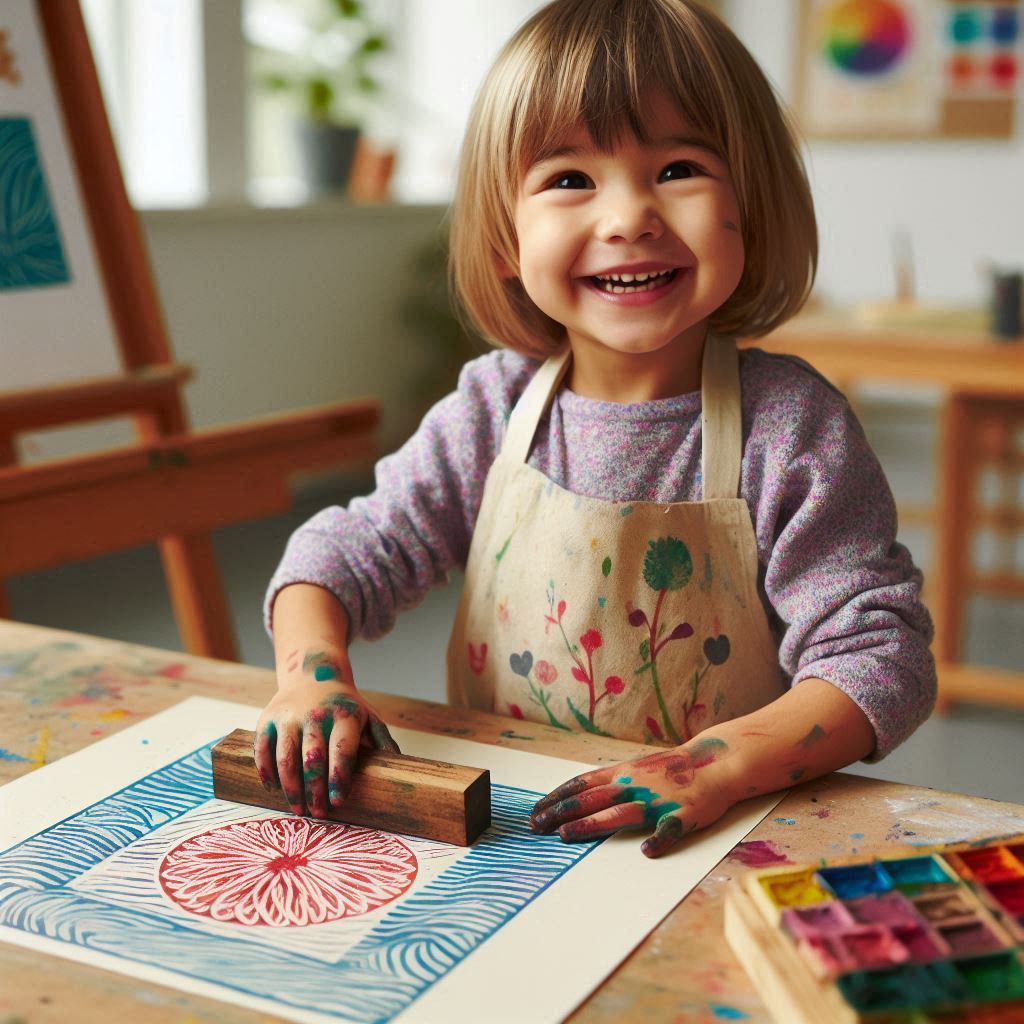Introduction
Printmaking for Children Art Education introduces young learners to a creative process of producing multiple images from a single design.
This artistic technique uses tools like stamps, rollers, and stencils, allowing children to explore texture, pattern, and repetition.
Incorporating printmaking into children’s art education offers several benefits:
- Enhances creativity by encouraging experimentation with materials.
- Improves fine motor skills through hands-on activities.
- Develops problem-solving abilities as children plan and execute their designs.
- Builds confidence through the satisfaction of producing multiple, tangible artworks.
Printmaking also encourages teamwork.
Group projects allow students to collaborate, share ideas, and create together.
This promotes social interaction and communication skills.
Additionally, printmaking exposes children to different cultures and art traditions, fostering a deeper understanding of diversity.
This makes printmaking a valuable tool in broadening children‘s artistic horizons.
Basically, printmaking not only enhances artistic skills but also supports overall development in a fun and engaging way.
Benefits of Printmaking for Children
Printmaking offers numerous advantages for children’s artistic development.
Here‘s how:
Improves Fine Motor Skills
Printmaking involves precise hand movements.
Children use tools like rollers and brayers to apply ink, enhancing their dexterity.
They learn to control pressure and movement, which strengthens fine motor skills.
Handling printmaking materials improves grip strength and coordination.
These skills transfer to other tasks like writing and typing.
Regular printmaking practice helps children develop better hand-eye coordination and manual control.
Encourages Creativity and Imagination
Printmaking provides a platform for endless creative exploration.
Children experiment with various textures and colors, stimulating their imagination.
They create unique patterns and designs, which enhances their problem-solving abilities.
Transform Your Career Today
Unlock a personalized career strategy that drives real results. Get tailored advice and a roadmap designed just for you.
Start NowThe process of transferring images to paper encourages innovative thinking.
Each print offers a new opportunity for artistic expression.
This freedom allows children to develop a personal style and creative vision.
Boosts Confidence Through Experimentation
Printmaking fosters a sense of accomplishment.
Children see immediate results from their efforts, boosting their self-esteem.
Experimenting with different techniques and materials helps them embrace mistakes as learning opportunities.
Each successful print reinforces their belief in their abilities.
The iterative process of creating and refining prints builds resilience and confidence.
Children gain a sense of pride in their creative achievements and are motivated to try new ideas.
In summary, printmaking supports children’s growth by enhancing fine motor skills, encouraging creativity, and boosting confidence.
Integrating printmaking into art education can significantly benefit children’s overall development, providing them with valuable skills and a greater appreciation for the creative process.
Read: Tips for Setting Up a Printmaking Studio
Types of Printmaking Techniques for Children
Block Printing
Block printing introduces children to a simple yet engaging technique.
Begin with a soft block like linoleum or rubber.
Children carve their designs into the block using safe tools.
Apply ink to the carved block and press it onto paper.
This method helps children understand the concept of positive and negative space.
It also allows them to explore patterns and textures.
Block printing is great for creating multiple prints from one design, making it a fun, repeatable activity.
Showcase Your Business Today
Reach thousands of readers actively exploring professional services. Publish your business profile and grow your audience now.
Publish NowMonoprinting
Monoprinting offers children a chance to experiment with unique, one-of-a-kind prints.
Start by applying ink or paint onto a smooth surface like a plate.
Children then manipulate the ink using brushes or tools to create designs.
Place a piece of paper over the inked plate and press gently.
Lift the paper to reveal the print.
Each print will be different, emphasizing spontaneity and creativity.
Monoprinting encourages exploration and helps children understand how their actions affect the final print.
Stencil Printing
Stencil printing is ideal for introducing children to shapes and patterns.
Begin by cutting out shapes or designs from a sturdy material like cardboard or plastic.
Place the stencil on paper and apply ink or paint over it.
Carefully remove the stencil to reveal the pattern.
This technique teaches children about layering and precision.
It also allows for consistent designs and is perfect for creating themed artworks.
Stencil printing is both simple and effective, making it accessible for young artists.
Collagraphy
Collagraphy introduces children to texture and mixed media.
Start by creating a collage on a plate using various materials like fabric, leaves, or cardboard.
Apply glue and let it dry.
Once dry, apply ink to the collaged plate and press it onto paper.
The result is a print rich in texture and detail.
Collagraphy helps children explore different materials and textures.
It also enhances their understanding of how different elements can come together to create a unified artwork.
Read: Understanding Color Theory in Printmaking
Materials Needed for Printmaking
Printmaking is a fantastic medium for children’s art education.
It introduces them to a world of creativity and technique.
Here‘s a look at the essential materials for printmaking.
Water-Based Ink
Water-based ink is a key material in printmaking.
It‘s non-toxic and easy to clean up, making it perfect for children.
This ink dries relatively quickly and provides vibrant colors.
It‘s also flexible, working well on various surfaces.
Choose a range of colors to allow for creative freedom.
Printing Paper
Selecting the right printing paper is crucial.
It needs to be strong enough to handle the pressure of printing.
Look for paper that is thick and absorbent.
High-quality printmaking paper will capture fine details and colors.
Encourage children to experiment with different types of paper to see how it affects their prints.
Brayers and Rollers
Brayers and rollers are used to apply ink evenly to your printing surface.
These tools help spread the ink smoothly, preventing clumps and ensuring an even application.
Brayers come in various sizes; choose ones that are comfortable for small hands.
They are essential for achieving consistent results and can add texture to the prints.
Carving Tools for Block Printing
Carving tools are used for block printing and are an exciting part of the printmaking process.
Showcase Your Business Today
Reach thousands of readers actively exploring professional services. Publish your business profile and grow your audience now.
Publish NowThese tools help children carve designs into a block of material, typically linoleum or wood.
Ensure that the tools are safe and suitable for children.
Introduce various shapes and sizes to help them create detailed and intricate designs.
In essence, using water-based ink, appropriate printing paper, brayers and rollers, and carving tools provides children with a solid foundation for exploring printmaking.
Each material plays a vital role in helping them produce beautiful and unique prints.
Encourage experimentation and creativity with these tools to enhance their art education.
Read: Exploring Modern Printmaking Trends

Step-by-Step Guide to Block Printing
Block printing offers a fun, hands-on introduction to art for children.
It allows young artists to express themselves creatively while learning fundamental art techniques.
Here‘s a simple step-by-step guide to block printing:
Choosing a Design
- Start by picking a simple design that appeals to your child.
- Keep the shapes bold and clear, as this will make carving easier.
- Encourage creativity by letting your child draw their own design or choose one they like.
Transferring the Design onto the Block
- Place tracing paper over the chosen design.
- Trace the design using a pencil, making sure to press firmly.
- Flip the tracing paper over the block and rub the back of the paper to transfer the image.
- Check to ensure the design has been fully transferred.
Carving the Design
- Use a carving tool to carve along the lines of the design.
- Start with outlining the larger sections, then move to the finer details.
- Teach children to carve away from their hands to ensure safety.
- Encourage them to take their time and enjoy the process.
Inking the Block and Printing
- Roll ink onto a flat surface using a brayer (roller).
- Evenly roll the ink onto the carved block.
- Carefully press the inked block onto a sheet of paper.
- Apply even pressure across the block for a clean print.
- Lift the block to reveal the printed design.
Block printing teaches patience, precision, and creativity.
Encourage your child to explore different designs, colors, and papers.
This fun, tactile experience offers endless possibilities, ensuring each print is unique!
Read: Printmaking Techniques: Aquatint and Mezzotint
Tips for Successful Printmaking with Children
Printmaking is a fantastic way to introduce children to art.
Here are some tips to ensure a successful experience:
Use Non-Toxic Materials
When working with children, safety is a top priority.
Always choose non-toxic inks, paints, and papers.
These materials are safer and environmentally friendly.
Make sure to check product labels to confirm their safety.
Avoid materials that might cause allergic reactions or other health issues.
Non-toxic supplies ensure that children can explore their creativity without risk.
Provide Examples and Demos
Children learn best through visual examples.
Before starting, show them various printmaking examples.
This could include prints from famous artists or simple examples you‘ve created.
Demonstrate each step of the process clearly.
Explain how to apply ink, press the paper, and reveal the print.
Seeing the process helps children understand what to expect and sparks their imagination.
Interactive demos make the learning process engaging and fun.
Encourage Experimentation and Creativity
Printmaking is all about creativity.
Encourage children to experiment with different techniques and materials.
Let them mix colors and try various textures.
Allow them to make mistakes and learn from them.
Celebrate their unique creations and ideas.
By fostering an environment where experimentation is encouraged, children will feel more confident in expressing themselves.
Creativity flourishes when children are given the freedom to explore and innovate.
Supervise Younger Children to Ensure Safety
Supervision is crucial, especially with younger children.
Always keep an eye on them during the printmaking process.
Ensure they use tools and materials correctly to avoid accidents.
Guide them through each step and provide assistance when needed.
Showcase Your Business Today
Reach thousands of readers actively exploring professional services. Publish your business profile and grow your audience now.
Publish NowSupervision also helps in managing the mess and ensuring that the workspace remains safe and clean.
Active supervision ensures that children stay safe and enjoy their creative experience.
Incorporating these tips into printmaking activities can create a positive and enriching experience for children.
Through safe practices and encouragement, you can help them develop a love for art and creativity.
Discover More: Key Steps in the Furniture Design Process
Incorporating Printmaking into Art Curriculum
Integrating printmaking into lesson plans
Integrating printmaking into lesson plans offers children a hands-on experience with art.
Start by introducing simple techniques such as monoprinting or linocut.
Design lessons around these methods to build students’ understanding progressively.
For younger students, focus on basic printmaking tools like foam plates and water-based inks.
Older students can explore more complex processes like etching or screen printing.
Each lesson should include clear instructions and objectives.
Connecting printmaking to art history and culture
Connecting printmaking to art history and culture enriches students’ learning experiences.
Begin by discussing famous printmakers like Hiroshige or Albrecht D‘rer.
Share how different cultures have used printmaking throughout history, such as Japanese ukiyo-e or African textile prints.
Show students examples of prints from various periods and regions.
This approach helps students appreciate the global significance of printmaking and inspires their creativity.
Collaborative printmaking projects for teamwork
Collaborative printmaking projects foster teamwork and communication among students.
Plan activities where students work in groups to create large-scale prints or mixed-media pieces.
Assign roles such as designers, printers, and assemblers to ensure every student contributes.
Encourage collaboration by having students share ideas and techniques during the project.
The final product will showcase their collective effort and highlight the value of working together.
Incorporating printmaking into the art curriculum brings dynamic and engaging elements to the classroom.
By integrating it into lesson plans, connecting it to art history and culture, and fostering teamwork through collaborative projects, you create a rich, multi-dimensional learning experience.
These activities not only enhance artistic skills but also build cultural awareness and collaborative abilities in young artists.
Explore Further: How to Start Your Own Web Design Business
Learn More: Freelance vs. In-House Industrial Design Careers
Showcasing Children’s Printmaking Artwork
Printing artwork created by children is a wonderful way to showcase their creativity and artistic abilities.
Here are some ideas on how to display and share their printmaking masterpieces:
Creating a Printmaking Gallery in the Classroom
Setting up a designated wall space or bulletin board in the classroom where children’s printmaking artwork can be displayed.
This provides an opportunity for students to see their work showcased and appreciated by their peers.
Encourage children to take pride in their creations by regularly rotating the artwork on display.
This not only keeps the gallery fresh but also allows for a variety of pieces to be featured over time.
Consider labeling each piece of artwork with the child’s name and a brief description of the printmaking technique used.
This helps children feel a sense of ownership and accomplishment over their work.
Hosting a Printmaking Exhibition for Parents and Community
Organize a special event, such as a printmaking exhibition, where children can invite their parents, family members, and community members to view their artwork.
This creates a platform for children to share their work with a wider audience.
Set up a gallery-style exhibition space outside of the classroom, such as in the school library or a dedicated art space.
This allows for a more formal presentation of the children’s printmaking artwork.
Encourage children to talk about their artwork to visitors, explaining the printmaking process, inspiration behind their pieces, and the techniques they used.
This helps to build confidence and communication skills in children.
Showcase Your Business Today
Reach thousands of readers actively exploring professional services. Publish your business profile and grow your audience now.
Publish NowEncouraging Children to Reflect on Their Work and Share Their Process
Promote reflection by having children write artist statements to accompany their printmaking artwork.
This can include details about their creative process, materials used, and what they learned from the experience.
Create opportunities for children to share their printmaking journey with their peers during show-and-tell sessions or class discussions.
This fosters a sense of community and allows for collaboration and feedback among students.
Encourage children to create a portfolio of their printmaking artwork, which can serve as a visual diary of their progress and development over time.
This allows children to track their growth as artists and see how their skills have evolved.
In a nutshell, showcasing children’s printmaking artwork not only celebrates their creativity but also helps to develop their artistic skills, confidence, and communication abilities.
By creating a printmaking gallery, hosting exhibitions, and encouraging reflection and sharing, educators can inspire a love for art in children and foster a supportive and creative learning environment.
Conclusion
Printmaking offers a wealth of benefits for children’s art education, enriching their creative and cognitive development.
Engaging in printmaking helps children explore different artistic techniques.
It nurtures their creativity, allowing them to experiment with patterns, colors, and textures.
The process of printmaking also enhances fine motor skills as children manipulate tools and materials.
This hands-on approach to art helps develop their problem-solving abilities, as they learn to plan and execute their designs.
Through printmaking, children gain a deeper understanding of the artistic process.
They see the results of their efforts, which boosts their confidence and sense of accomplishment.
This medium encourages patience and persistence, as creating prints often involves several steps and revisions.
Additionally, printmaking can be a collaborative activity, fostering teamwork and communication among peers.
For educators and parents, incorporating printmaking into children’s artistic development is a valuable opportunity.
Printmaking activities can be easily adapted to different age groups and skill levels.
They offer a range of possibilities for integrating art with other subjects, such as history and science, through themed projects.
By introducing printmaking, educators can provide children with diverse artistic experiences that go beyond traditional drawing and painting.
Encourage children to explore printmaking techniques at home and in the classroom.
Create a supportive environment where experimentation and creativity are celebrated.
Provide the necessary materials and guidance, and let children take the lead in their artistic exploration.
This approach will not only enhance their artistic skills but also cultivate a lifelong appreciation for the arts.
Incorporating printmaking into children’s art education is a rewarding endeavor.
It provides numerous benefits that contribute to their overall growth and development.
Embrace printmaking as a powerful tool for nurturing creativity and fostering a love for art.
[E-Books for Sale]
The Big Book of 500 High-Paying Jobs in America: Unlock Your Earning Potential
$19.99 • 500 High-Paying Jobs • 330 pages
Explore 500 high-paying jobs in America and learn how to boost your career, earn more, and achieve success!
See All 500 High-Paying Jobs of this E-Book
1001 Professions Without a Degree: High-Paying American Jobs You Can Start Now
$19.99 • 1001 Professions Without a Degree • 174 pages
Discover 1001 high-paying jobs without a degree! Unlock career tips, skills, and success strategies for just $19.99!




